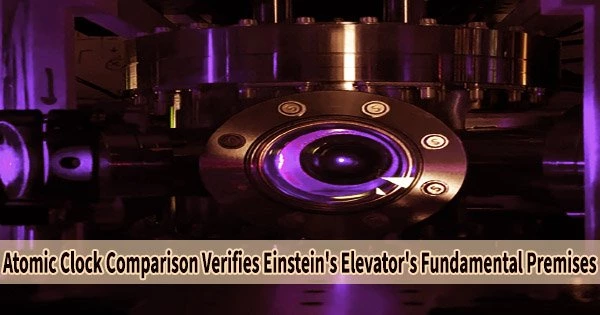Scientists at the National Institute of Standards and Technology (NIST) have conducted the most precise test ever of a crucial principle underlying Albert Einstein’s well-known theory of general relativity, which explains how gravity relates to space and time. They did this by comparing various types of remote atomic clocks.
The NIST result gives a record-low, astronomically minuscule number for a quantity that Einstein predicted would be zero. This result was made possible by ongoing advancements in the most precise atomic clocks in the world.
According to an article published in Nature Physics on June 4, 2018, and made available online, NIST scientists tested Einstein’s theory of the Earth acting as a free-falling elevator by using the solar system as a testing ground.
According to Einstein’s theory, all objects found inside such an elevator would accelerate uniformly, or as if there were no gravity at all. In addition, he projected that during the elevator’s free fall, these objects’ relative characteristics would not change.
The NIST team modeled Earth as an elevator plummeting into the gravitational field of the Sun for the sake of their experiment. In spite of variations in the gravitational pull on the elevator caused by the Earth’s somewhat eccentric orbit around the sun, they were able to demonstrate that two different types of atomic clocks positioned around the world remained in sync for 14 years by comparing recorded data on their “ticks.”
Researchers compared data from 1999 to 2014 for a total of 12 clocks four hydrogen masers (microwave lasers) in the NIST time scale with eight of the most accurate cesium fountain atomic clocks operated by metrology laboratories in the United States, the United Kingdom, France, Germany and Italy.
But the main reason we did this work was to highlight how atomic clocks are used to test fundamental physics; in particular, the foundations of general relativity. This is the claim made most often when clockmakers strive for better stability and accuracy. We tie together tests of general relativity with atomic clocks, note the limitations of the current generation of clocks, and present a future outlook for how next-generation clocks will become very relevant.
Bijunath Patla
The experiment was created to test the local position invariance (LPI) principle, which states that measurements of nongravitational effects in a falling elevator are independent of time and place.
One such measurement contrasts the electromagnetic radiation frequencies coming from several places’ atomic clocks. The researchers limited the LPI violation to a value of 0.00000022 plus or minus 0.00000025, the tiniest figure ever, which is consistent with the zero result anticipated by general relativity and denotes no violation. This indicates that when the clocks moved in unison in the falling elevator, the ratio of hydrogen to cesium frequencies remained unchanged.
This result is five times more sensitive than NIST’s best prior measurement of the LPI violation because it has a five-fold lower level of uncertainty. This earlier result from 2007 came from a 7-year comparison of atomic clocks made of cesium and hydrogen, and it was 20 times more sensitive than the prior testing.
The latest measurement advance is due to improvements in several areas, namely more accurate cesium fountain atomic clocks, better time transfer processes (which enable devices at different locations to compare their time signals), and the latest data for computing the position and velocity of Earth in space, NIST’s Bijunath Patla said.
“But the main reason we did this work was to highlight how atomic clocks are used to test fundamental physics; in particular, the foundations of general relativity,” Patla said. “This is the claim made most often when clockmakers strive for better stability and accuracy. We tie together tests of general relativity with atomic clocks, note the limitations of the current generation of clocks, and present a future outlook for how next-generation clocks will become very relevant.”
According to the researchers, it is unlikely that additional limits on LPI can be found using hydrogen and cesium clocks, but experimental next-generation clocks based on optical frequencies, which are much higher than the frequencies of hydrogen and cesium clocks, could provide results that are much more accurate. Many similar clocks based on elements like ytterbium and strontium are already in use at NIST.
NIST researchers utilized their new value for the LPI violation to calculate variations in numerous fundamental “constants” of nature, physical quantities assumed to be universal and frequently employed in physics.
This is because so many scientific ideas and calculations are interconnected. Their findings for the fine structure constant corresponded with values previously published for any pair of atoms, but their findings for the light quark mass were the best ever.
The work was funded in part by the National Aeronautics and Space Administration.
















